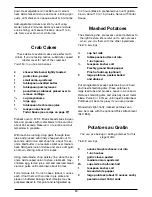
14
French-cut green beans
Trim fresh green beans to feed-tube widths.
Blanch them for 60 seconds in boiling, salted
water. Plunge them immediately into cold water
to stop the cooking. When they are cold to the
touch, drain and dry them. Stack them in the feed
tube horizontally to about 1 inch from the top.
Use the standard 4mm Slicing Disc.
Be sure the small pusher is locked and the slide
lock in the sleeve is unlocked. Apply light pres-
sure to the pusher and press the lever down to
PULSE until beans are sliced. To make long, hor-
izontal slices or shreds of raw zucchini or carrots,
use the same procedure.
Matchsticks or julienne strips
Process the food twice to “double-slice” it. Insert
any large fruit or vegetable — potatoes, turnips,
zucchini, apples — in the feed tube horizontally.
Apply pressure to the pusher while pressing the
lever down to PULSE until the food is sliced. You
will get long slices. Remove the slices from the
work bowl and reassemble them as described.
Reinsert them in the feed tube, wedging them
in tightly. Slice them again. You will obtain long
julienne strips. With the optional Square Julienne
Disc, you can make square julienne strips in one
operation.
SLICING MEAT AND POULTRY
Cooked meat and poultry
The food must be very cold. If possible, use a
chunk of food just large enough to fit the feed
tube. To make julienne strips of ham, bologna or
luncheon meat, stack slices of them. Then roll or
fold them double and stand them upright in the
feed tube, wedging in as many rolls as possible.
This technique works better with square or
rectangular pieces than with round ones.
Uncooked meat and poultry
Cut the food into pieces to fit the feed tube.
Boned, skinned chicken breasts will usually fit
when cut in half crosswise. Wrap the pieces in
plastic wrap and put them in the freezer. They are
ready to slice when they pass this “knife test.”
They are easily pierced with the tip of a sharp
knife although semi-frozen and hard to the touch.
Stand them in the feed tube, cut side down, and
slice them
against
the grain, using firm pressure
on the pusher. Or lay them flat in the feed tube, as
many as will fit, and slice
with
the grain, using firm
pressure.
Frankfurters, salami and other sausages
If the sausage is soft, freeze it until it is hard to
the touch, but easily pierced with the tip of a
sharp knife. Hard sausages need not be frozen. If
the sausage is thin enough to fit in the small feed
tube, use that tube. Otherwise, cut the sausage
into pieces to completely fit the large feed tube.
Stand the pieces vertically, packing them in tightly
so they cannot tilt sideways.
SLICING AND SHREDDING CHEESE
Firm cheeses like Swiss and Cheddar
Cut the cheese into pieces to fit the feed tube. Be
sure that cheese is very well chilled – placing it in
the freezer for 5 to 10 minutes helps. Stand the
pieces in the feed tube and apply light pressure to
the pusher.
IMPORTANT:
Never try to slice soft cheese like
mozzarella or hard cheese like Parmesan. You
may damage the slicing disc or the food pro-
cessor itself. You can successfully shred most
cheeses except for the softer ones. The exception
is mozzarella, which shreds well if thoroughly
chilled. Hard cheeses like Parmesan shred well
only at room temperature.
Therefore, attempt to shred mozzarella or
Parmesan only when at the appropriate tempera-
ture; otherwise the cheeses will not shred well or
damage to the machine could occur.
TYPE OF CHEESE
CHOP
SHRED SLICE
Soft
yes
no
no
Brie, Camembert,
ricotta, cottage, cream
exception: mozzarella
yes yes
no
chill
Semi-Soft
yes
yes
no
Blue,
chill
Fontina,
chill
Bel Paese
chill
Semi-Hard
yes
yes
yes
Cheddar, Monterey Jack
chill chill
Swiss, Jarlsberg,
chill
chill
Edam, Gouda,
chill
chill
Provolone
chill
chill
Hard
yes
yes
no
Parmesan, Romano,
room
Pecorino, Asiago
temp.
Содержание PRO CUSTOM 11 DLC-8S
Страница 17: ...17 NOTES ...
Страница 35: ...35 NOTES ...
Страница 36: ... 2016 Cuisinart 150 Milford Road East Windsor NJ 08520 Printed in China 16CE019155 G IB 4274 ESP ...















































